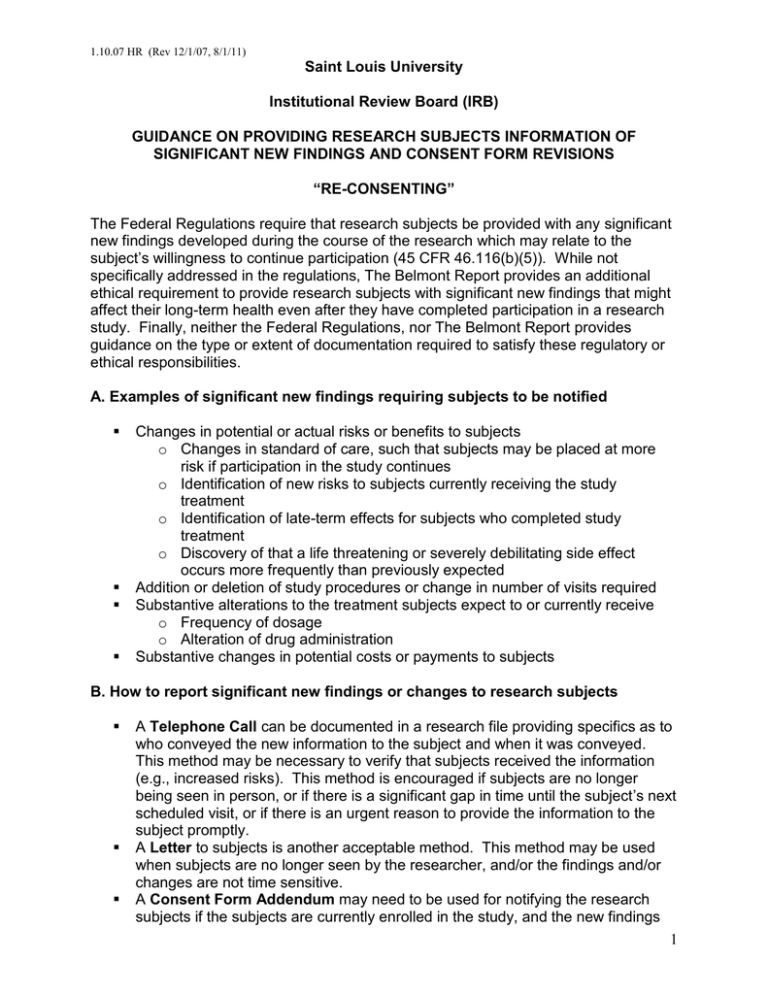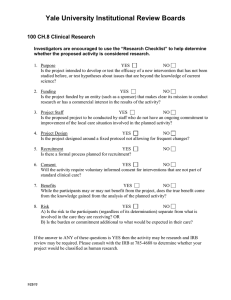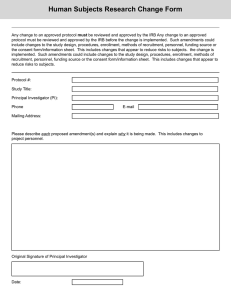Re-Consenting Subjects
advertisement

1.10.07 HR (Rev 12/1/07, 8/1/11) Saint Louis University Institutional Review Board (IRB) GUIDANCE ON PROVIDING RESEARCH SUBJECTS INFORMATION OF SIGNIFICANT NEW FINDINGS AND CONSENT FORM REVISIONS “RE-CONSENTING” The Federal Regulations require that research subjects be provided with any significant new findings developed during the course of the research which may relate to the subject’s willingness to continue participation (45 CFR 46.116(b)(5)). While not specifically addressed in the regulations, The Belmont Report provides an additional ethical requirement to provide research subjects with significant new findings that might affect their long-term health even after they have completed participation in a research study. Finally, neither the Federal Regulations, nor The Belmont Report provides guidance on the type or extent of documentation required to satisfy these regulatory or ethical responsibilities. A. Examples of significant new findings requiring subjects to be notified Changes in potential or actual risks or benefits to subjects o Changes in standard of care, such that subjects may be placed at more risk if participation in the study continues o Identification of new risks to subjects currently receiving the study treatment o Identification of late-term effects for subjects who completed study treatment o Discovery of that a life threatening or severely debilitating side effect occurs more frequently than previously expected Addition or deletion of study procedures or change in number of visits required Substantive alterations to the treatment subjects expect to or currently receive o Frequency of dosage o Alteration of drug administration Substantive changes in potential costs or payments to subjects B. How to report significant new findings or changes to research subjects A Telephone Call can be documented in a research file providing specifics as to who conveyed the new information to the subject and when it was conveyed. This method may be necessary to verify that subjects received the information (e.g., increased risks). This method is encouraged if subjects are no longer being seen in person, or if there is a significant gap in time until the subject’s next scheduled visit, or if there is an urgent reason to provide the information to the subject promptly. A Letter to subjects is another acceptable method. This method may be used when subjects are no longer seen by the researcher, and/or the findings and/or changes are not time sensitive. A Consent Form Addendum may need to be used for notifying the research subjects if the subjects are currently enrolled in the study, and the new findings 1 1.10.07 HR (Rev 12/1/07, 8/1/11) or changes are the only changes being made to the consent form or protocol. If a revised consent form will be used instead of a consent form addendum, revisions should be highlighted in some way to draw the subject’s attention to the new information. In some cases, the investigator may want to combine several of these approaches. For example, if there is significant new risk information that emerges during a trial, such that significant changes are required in study procedures, the investigator may want to contact the patient by telephone or letter, as well as re-consent them when they are next seen for a study visit. C. IRB Review The IRB should review and approve notifications prior to their dissemination, unless the information must be provided immediately to protect subjects or others from immediate harm. Changes should be submitted on the Change In Protocol form (Amendment in eIRB). If an oral method is being used to notify subjects (phone call), the IRB should receive and review a script or description of the information being conveyed to the subject. D. Re-consent is NOT necessary when Minor administrative changes are made to the consent form (e.g., version dates, expiration dates, minor increase in subjects accrual, font changes, etc.) There is addition of study procedures or visits not pertaining to the subjects already enrolled in the study (e.g., screening procedures) E. Documentation It is very important to document communication with research subjects. The regulatory files should be updated with IRB submissions and approval. Upon conveying the information to the research subjects, each subject’s research file should also be updated with this communication clearly documented. F. Further questions In situations where the investigator has questions regarding whether to contact subjects and/or how to contact subjects, consultation should be sought with the IRB in order to resolve the questions in a prompt manner. 2

